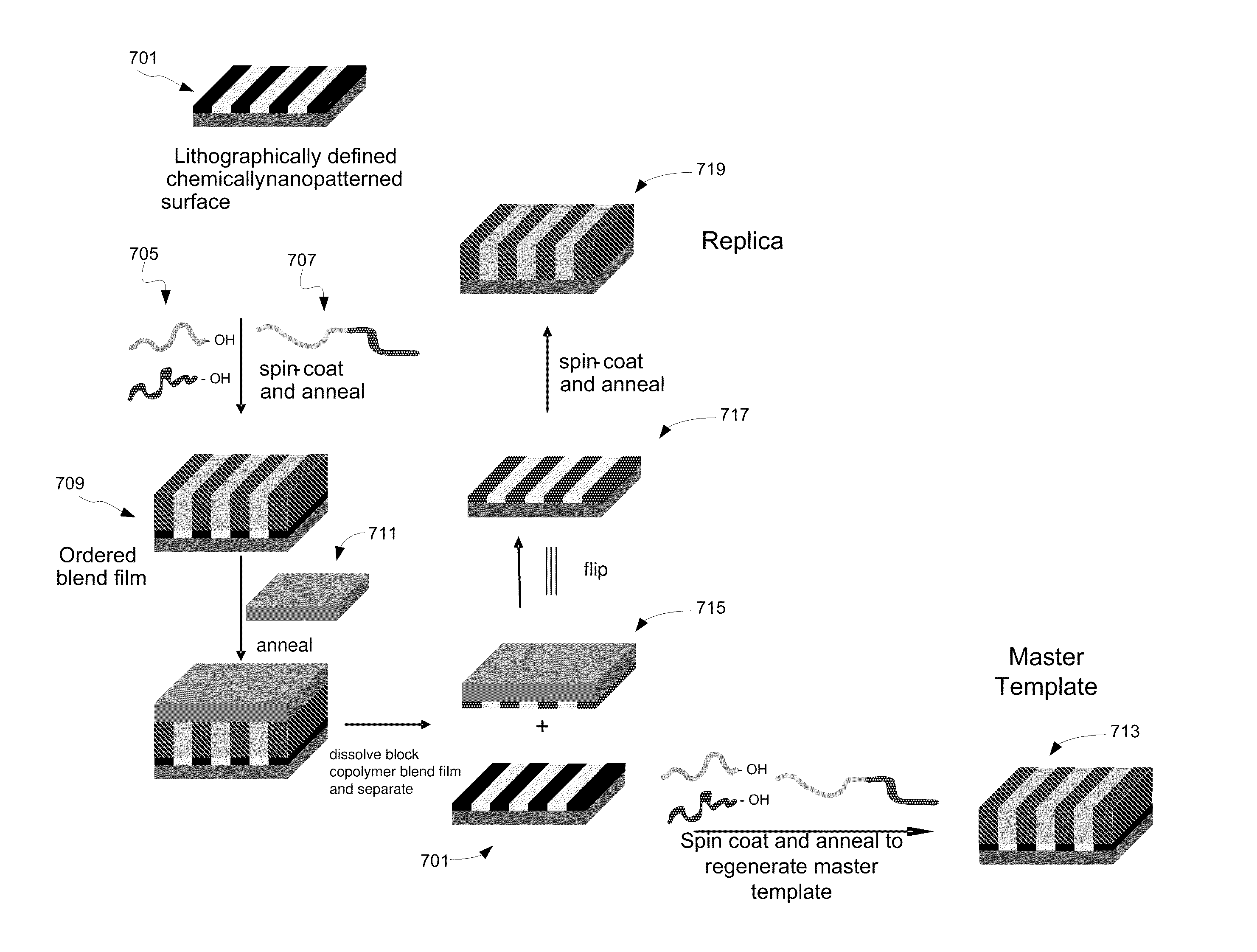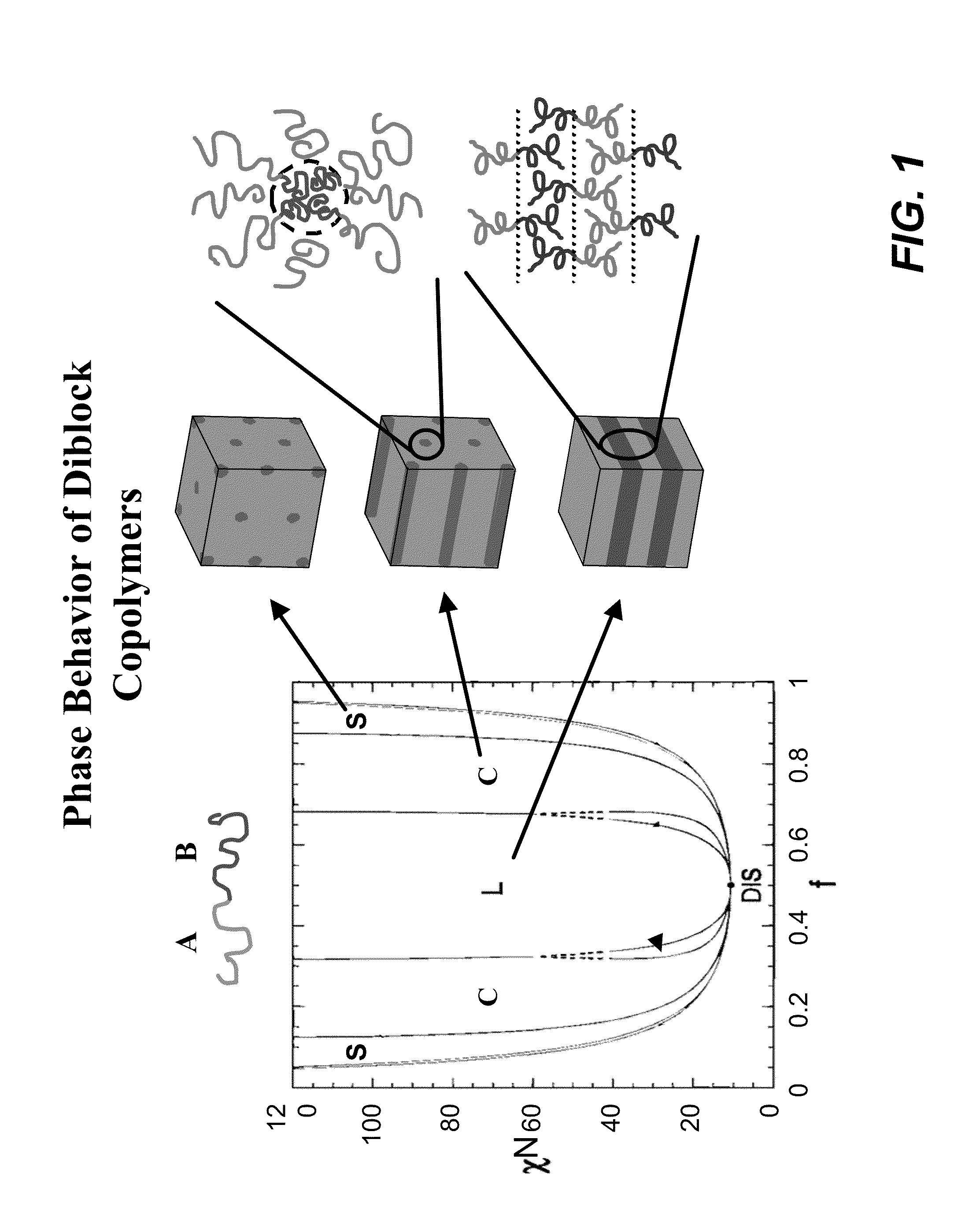Molecular transfer printing using block copolymers
a technology of copolymer and molecular transfer, applied in the direction of photomechanical equipment, instruments, synthetic resin layered products, etc., can solve the problems of prohibitively high cost of optical lithography and technological impasse, and achieve the effect of limiting the resolution of the techniqu
- Summary
- Abstract
- Description
- Claims
- Application Information
AI Technical Summary
Benefits of technology
Problems solved by technology
Method used
Image
Examples
examples
[0100]The following examples provide details illustrating aspects of the present invention. These examples are provided to exemplify and more clearly illustrate these aspects of the invention and are in no way intended to be limiting.
Experimental Procedure
examples 1-3
The following experimental procedure was used to transfer chemical patterns to Si wafers in the some of the below examples:
[0101]Block copolymer: PS-b-PMMA
[0102]Inks: PS-OH (preferentially to PS domains) and PMMA-OH (preferential to PMMA domains)
[0103]Forming blend film on neutral or chemically nanopatterned first substrate: Spin-coat 1.5% PS-b-PMMA (52K-52K) with PS-OH (6K, 5% relative to PS-b-PMMA) and PMMA-OH (6K, 5% relative to PS-b-PMMA); Anneal at 190° C. for 1 day (or 230° C. for 3 min) or w / o annealing
[0104]Transferring pattern: cover first substrate with Si wafer, and anneal at 160° C. for 2 days (or varying annealing conditions)
[0105]Separating substrates: sonicate in toluene to separate wafers and remove unbound polymers
[0106]Using transferred pattern to direct assembly of block copolymer film: Spin-coat PS-b-PMMA (or blend) on the top cover wafer and anneal at 230° C. for 3 min or 190° C. for 1 day.
example 1
[0107]A master template was formed from the directed assembly of the block copolymer film on a lithographically defined chemically nanopatterned substrate using the experimental procedure outline above. The period of the parallel alternating poly(styrene) (PS) and poly(methylmethacrylate) (PMMA) lamellar domains was 47.5 nm. The pattern was transferred to a second substrate. The transferred pattern was then used to direct the assembly of a block copolymer film to form a replica and the master template was regenerated using a process as described with reference to FIG. 7a. The process repeated 20 times to produce 20 replicas and regenerate the master template 20 times.
[0108]FIG. 12 shows SEM images of the master template regenerated after the 1st cycle, and that regenerated after the 20th cycle. No substantial differences were observed between the quality of the master templates from cycle to cycle, showing that the original lithographically defined chemical pattern is durable.
[0109]...
PUM
| Property | Measurement | Unit |
|---|---|---|
| glass transition temperatures | aaaaa | aaaaa |
| glass transition temperature | aaaaa | aaaaa |
| glass transition temperature | aaaaa | aaaaa |
Abstract
Description
Claims
Application Information
 Login to View More
Login to View More - R&D
- Intellectual Property
- Life Sciences
- Materials
- Tech Scout
- Unparalleled Data Quality
- Higher Quality Content
- 60% Fewer Hallucinations
Browse by: Latest US Patents, China's latest patents, Technical Efficacy Thesaurus, Application Domain, Technology Topic, Popular Technical Reports.
© 2025 PatSnap. All rights reserved.Legal|Privacy policy|Modern Slavery Act Transparency Statement|Sitemap|About US| Contact US: help@patsnap.com



